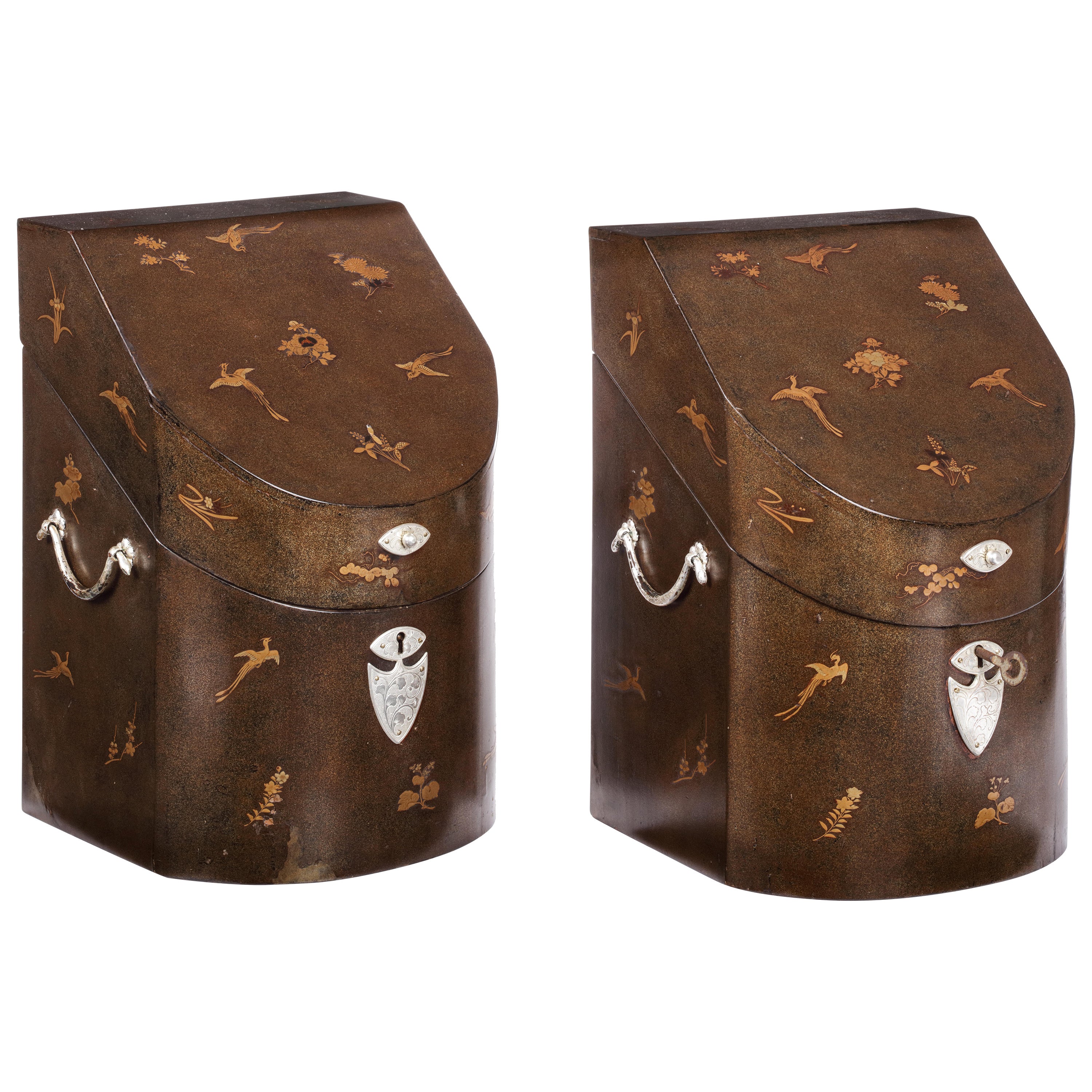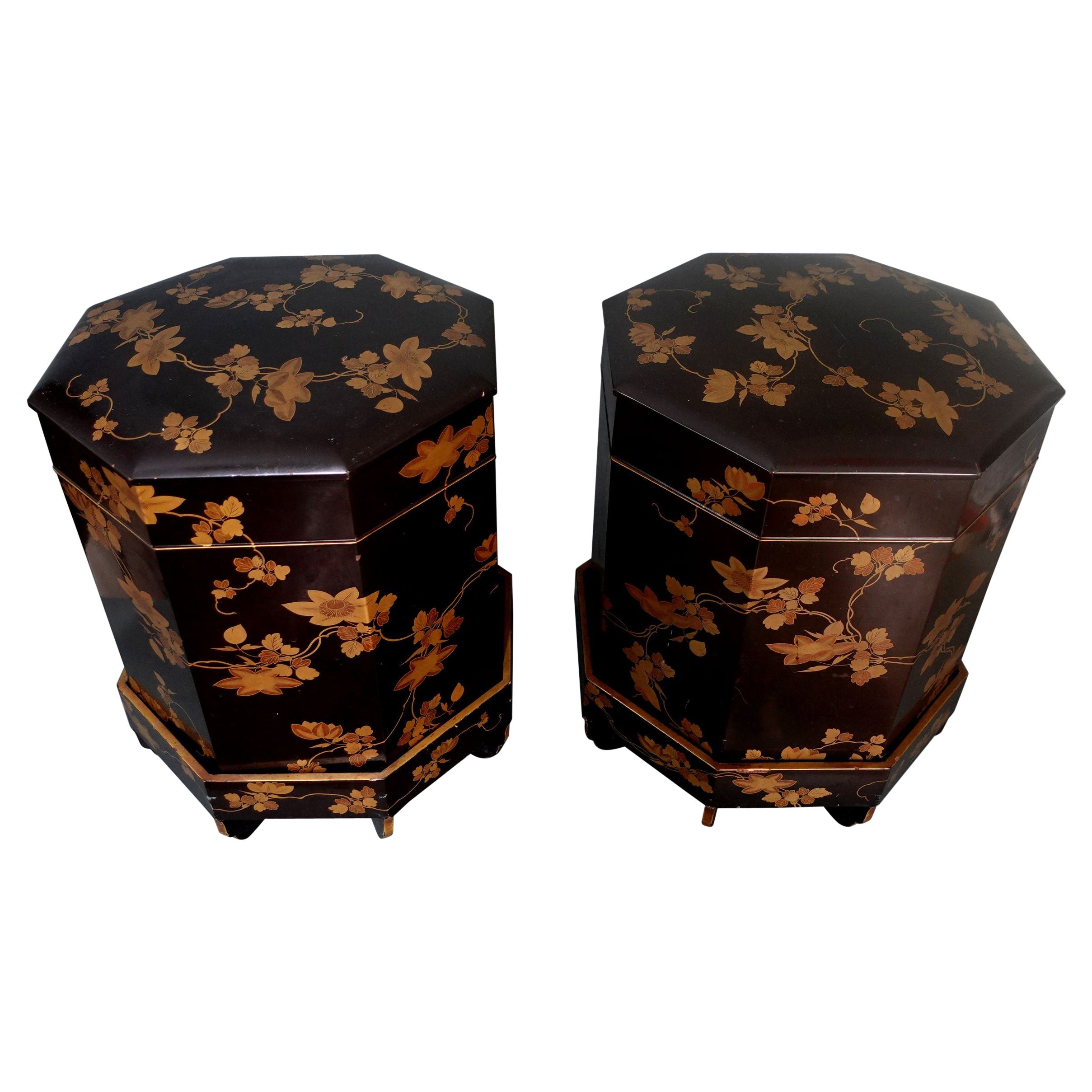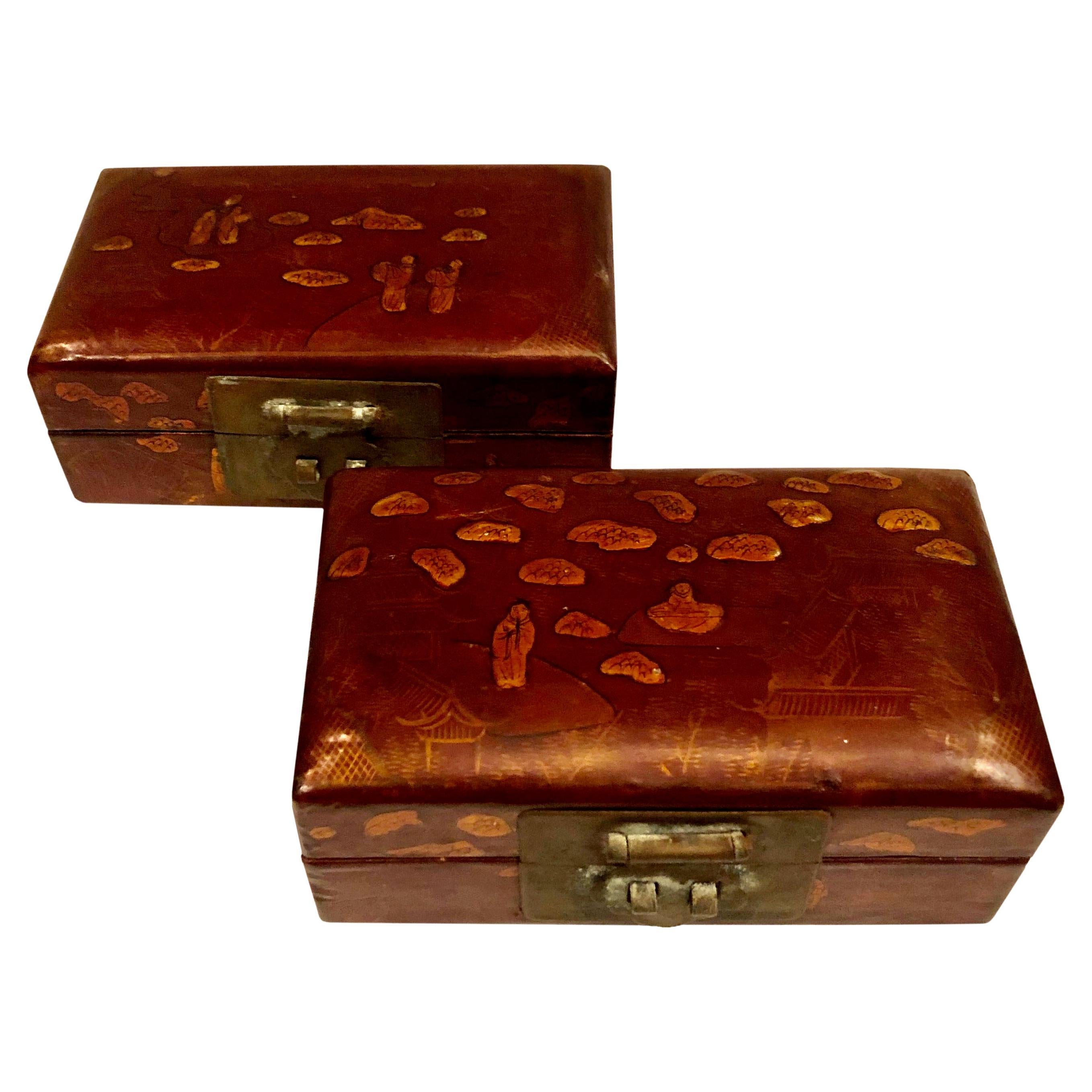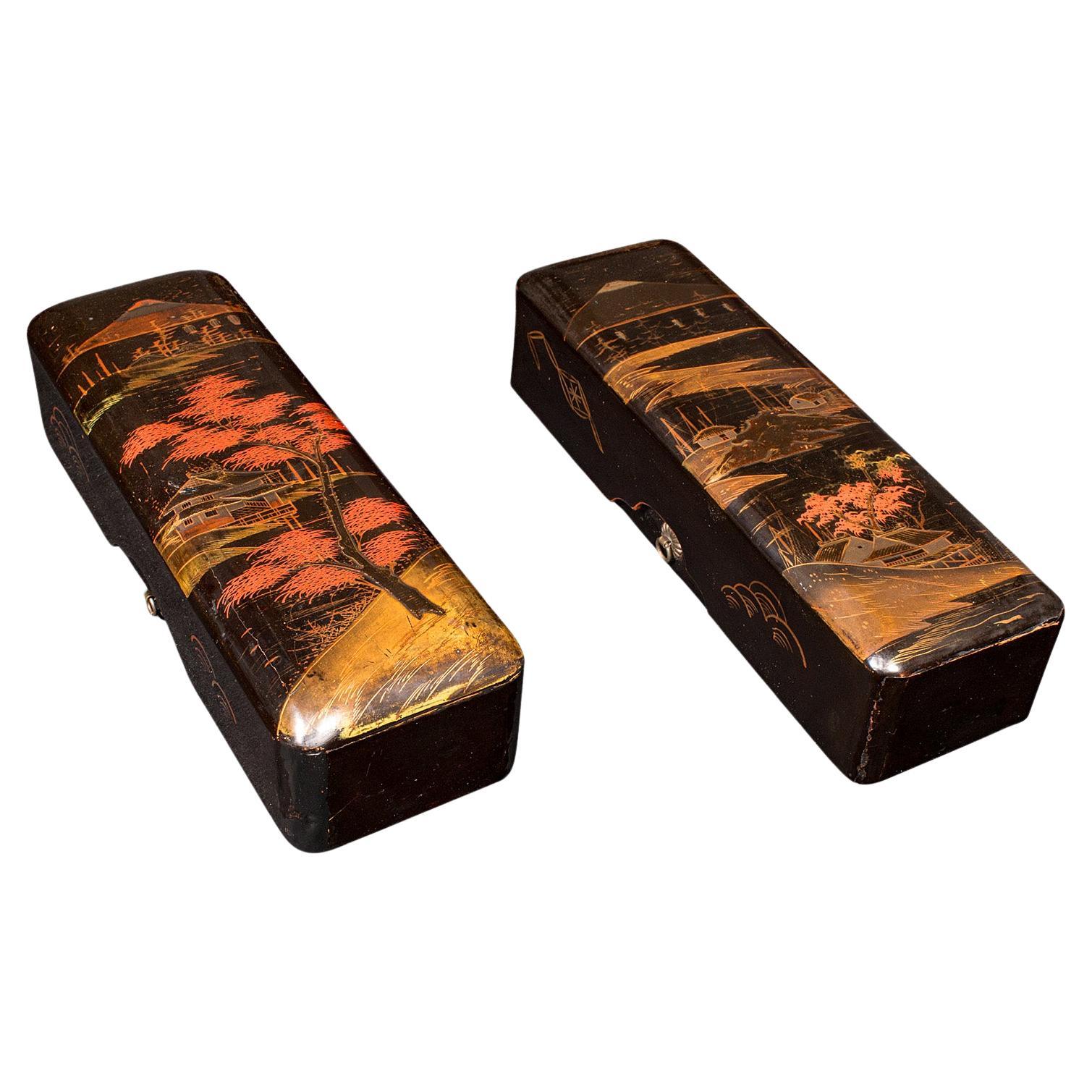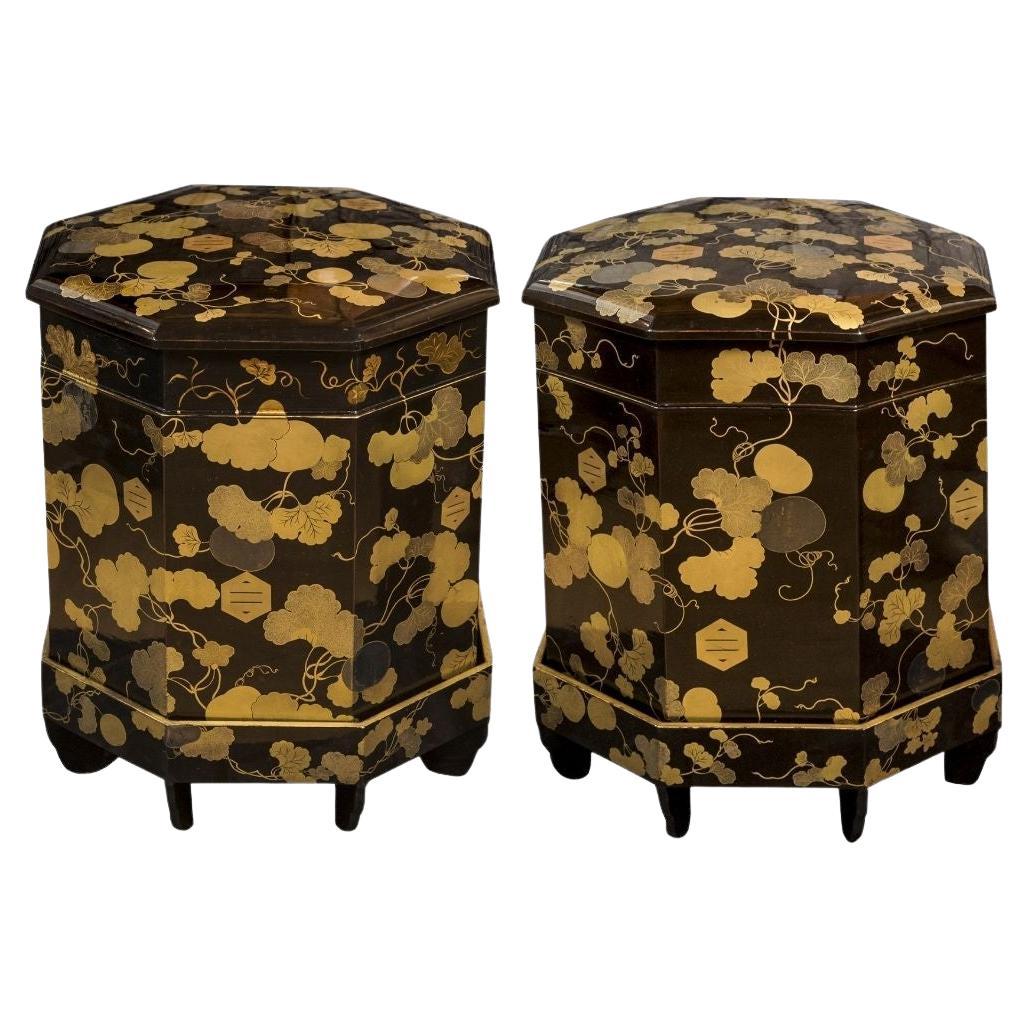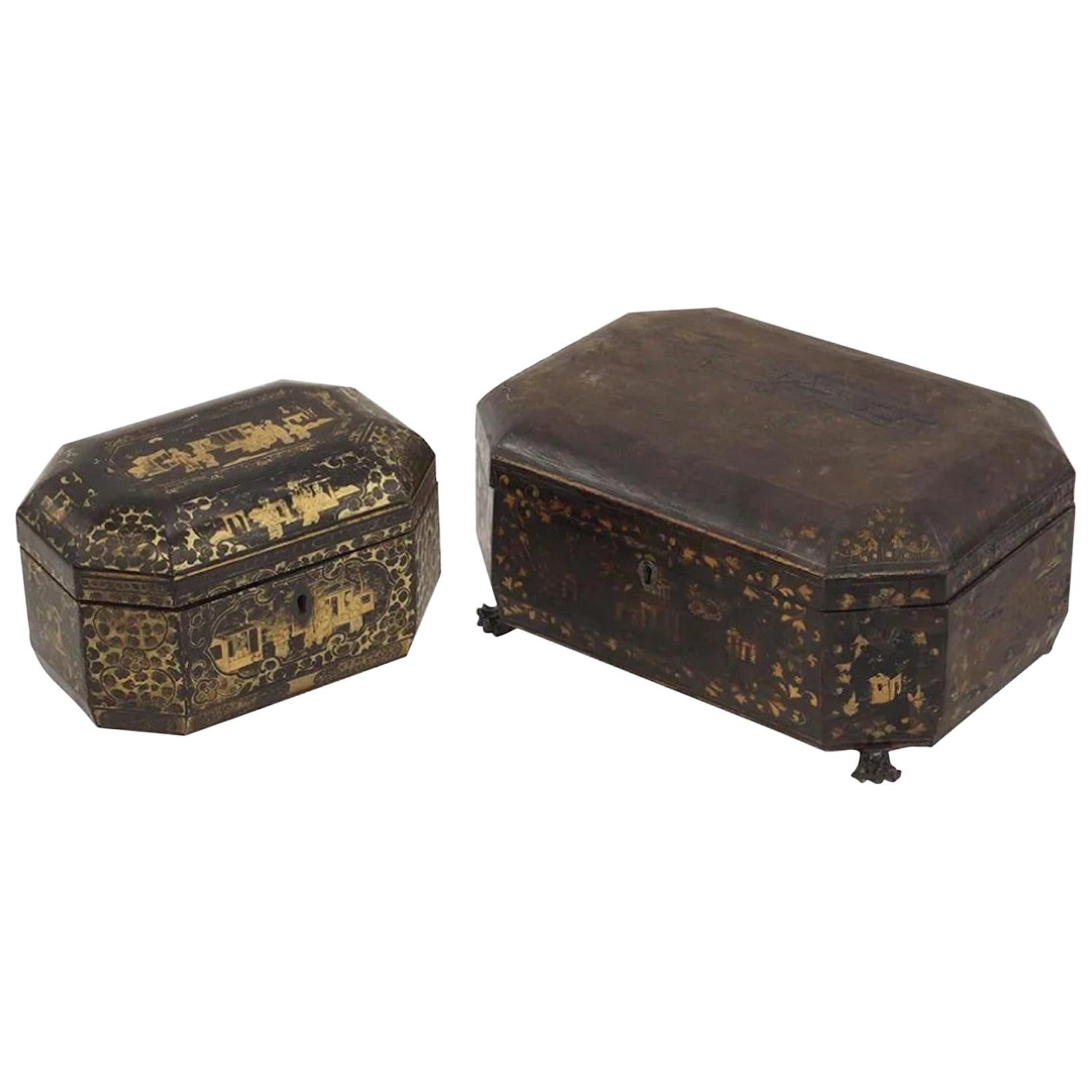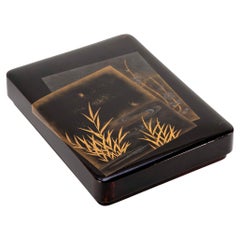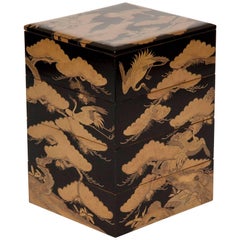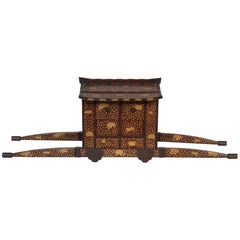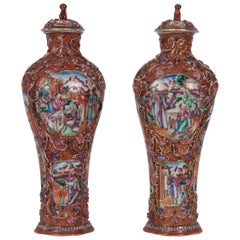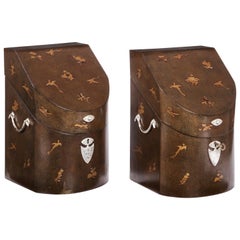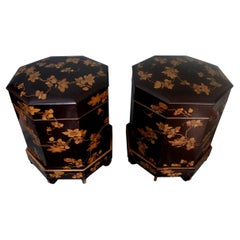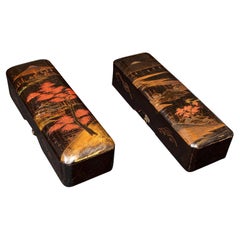Items Similar to Rare pair of Japanese Nagasaki Export Lacquered Wood Knife Boxes
Want more images or videos?
Request additional images or videos from the seller
1 of 16
Rare pair of Japanese Nagasaki Export Lacquered Wood Knife Boxes
$3,950per set
£2,970.13per set
€3,434.38per set
CA$5,574.54per set
A$6,048.66per set
CHF 3,208.70per set
MX$74,277.03per set
NOK 39,681.19per set
SEK 37,578.04per set
DKK 25,636.25per set
About the Item
Rare pair of Japanese Nagasaki Export lacquered wood knife boxes with mother-of-pearl inlay of flowers and birds, now converted to letter boxes. The boxes were converted to letter boxes in the late 19th c. as shown in photograph.
From Sutton Place townhouse of the Heinz family.
FW 1654
- Dimensions:Height: 13.5 in (34.29 cm)Width: 8.75 in (22.23 cm)Depth: 7.5 in (19.05 cm)
- Sold As:Set of 2
- Style:Anglo-Japanese (Of the Period)
- Materials and Techniques:Wood,Lacquered
- Place of Origin:
- Period:
- Date of Manufacture:1800
- Condition:Additions or alterations made to the original: Converted to letter boxes as mentioned in the description. Wear consistent with age and use. Ready to place.
- Seller Location:Stamford, CT
- Reference Number:Seller: Avery & Dash - FW171stDibs: LU918618365072
About the Seller
4.9
Vetted Professional Seller
Every seller passes strict standards for authenticity and reliability
Established in 1999
1stDibs seller since 2011
554 sales on 1stDibs
Typical response time: 4 hours
- ShippingRetrieving quote...Shipping from: Stamford, CT
- Return Policy
Authenticity Guarantee
In the unlikely event there’s an issue with an item’s authenticity, contact us within 1 year for a full refund. DetailsMoney-Back Guarantee
If your item is not as described, is damaged in transit, or does not arrive, contact us within 7 days for a full refund. Details24-Hour Cancellation
You have a 24-hour grace period in which to reconsider your purchase, with no questions asked.Vetted Professional Sellers
Our world-class sellers must adhere to strict standards for service and quality, maintaining the integrity of our listings.Price-Match Guarantee
If you find that a seller listed the same item for a lower price elsewhere, we’ll match it.Trusted Global Delivery
Our best-in-class carrier network provides specialized shipping options worldwide, including custom delivery.More From This Seller
View AllBlack and Gold Lacquer Japanese Suzuribako Box
Located in Stamford, CT
19th century Japanese black and gold lacquer Suzuribako box with firefly and plum blossom design.
Category
Antique Late 19th Century Japanese Decorative Boxes
Materials
Lacquer
Japanese Black Lacquer Jubako Box with Stork Motif
Located in Stamford, CT
A four-tier Japanese Meiji period black lacquer Jubako box with stork and fir tree decoration. Box in four sections with lid.
Category
Antique Late 19th Century Japanese Edo Lacquer
Materials
Lacquer
Japanese Edo-Meiji Period Lacquered Palanquin
Located in Stamford, CT
A Japanese Edo-Meiji period Palanquin chair for the childrens festival. The form with sliding and hinged doors, decorated in gold hiramaki-e with peonies ...
Category
Antique 1890s Japanese Edo More Asian Art, Objects and Furniture
Materials
Lacquer
Fabulous Pair of 18th Century Chinese Covered Urns
Located in Stamford, CT
A fabulous pair of 18th century Chinese Rose Mandarin covered urns with extraordinary detail and raised decoration.
Category
Antique 18th Century Chinese Ceramics
Materials
Porcelain
$12,000 / set
Pair of Mid-Century Modern Parchment Cabinets in the manner of Karl Springer
By Karl Springer
Located in Stamford, CT
Pair of Mid-Century Modern parchment covered two door cabinets on ebonized bases. In the style of Karl Springer.
Category
Vintage 1970s American Modern Commodes and Chests of Drawers
Materials
Parchment Paper
Pair of 19th Century Chinese Guan Type Vases
Located in Stamford, CT
Pair of 19th century Chinese Guan type vases in bottle form with gentle broad fluting.
Category
Antique 19th Century Chinese Qing Vases
Materials
Porcelain
You May Also Like
Pair of Fine Japanese Export Lacquer Cutlery Knife Boxes, 18th Century
Located in Amsterdam, NL
A pair of fine Japanese export lacquered cutlery boxes
Kyoto or Nagasaki, late 18th century
H. 33.5 x W. 24 x D. 21 cm
The bow-fronted boxes with sloping lids flat at the top are made of hinoki wood (Cypress), coated with Japanese paper and decorated in lacquer with scattered gold birds and flowers on a nashiji background. The Japanese mounts are made of copper and both boxes still have internal partitions to keep the cutlery upright.
The form of these boxes is similar to a pictorial-style knife box in the collection of the Groninger Museum (inv. 1989- 347), dated between 1730 and 1780, but the style of the decoration is more like that on a knife box in the Peabody Essex Museum in Salem (inv. E62271), which was brought to Salem by James Devereux, Captain of the Franklin, in 1799.
Provenance:
Henriette Jeane Christine van Neukirchen, called Nyvenheim (1807- 1849) and Nicolaas Johan Steengracht van Oostcapelle (1806-1866), thence by descent to the last owners, Ludolphine Emilie baronesse Schimmelpenninck van der Oye (1944) married in 1969 to Roland Daniel van Haersma Buma (1944), the last residents of castle Duivenvoorden near Voorschoten and the great-great-granddaughter of Nicolaas Johan Steengracht van Oostcapelle.
There is no evidence that Nicolaas Johan himself, or any of his or his wife’s ancestors had ever been in Japan. However, Nicolaas’ grandfather (Nicolaas Steengracht, 1754-1840) was a director of both the VOC and WIC (West Indies Company...
Category
Antique Late 18th Century Japanese Lacquer
Materials
Silver
A Pair of Large Japanese Lacquer Kaioke Boxes
Located in Norton, MA
Japan, late Edo, two big octagonal covered shell game boxes resting on footed stands, with makie-e decorations depicting flowering vines on a black lacquer ground,
They are still in ...
Category
Antique 19th Century Japanese Decorative Boxes
Materials
Lacquer
$18,500 / set
Early 19th Century Chinese Boxes with Oriental Figures, a Pair
Located in Tampa, FL
A fabulous pair of early 19th century Chinese boxes with hand carved oriental figures on the exterior and Handpainted figures on the interior....
Category
Antique Early 19th Century Chinese Decorative Boxes
Materials
Brass
Pair of Antique Glove Boxes, Japanese Lacquered Lidded Dishes, Victorian, C.1900
Located in Hele, Devon, GB
This is a pair of antique glove boxes. A Japanese, lacquered lidded dish, dating to the late Victorian period, circa 1900.
Delightfully decorative...
Category
Early 20th Century Japanese Japonisme Decorative Boxes
Materials
Lacquer
Japanese pair of kaioke boxes or Hokkaibako made of black and gold lacquer
Located in PARIS, FR
Two large eight-sided kaioke boxes in black lacquer, decorated with mon and maple leaves in golden lacquer.
These are usually octagonal boxes containing the painted shells used in ...
Category
Antique Late 19th Century Japanese Meiji Lacquer
Materials
Gold
Two Chinese Export Lacquered Tea Caddy for the English Market, Priced Per Caddy
Located in Buchanan, MI
A two Chinese export lacquered tea caddys for The English Market. With two fitted pewter canisters on the interior. Together with a Chinese export lacq...
Category
Antique 19th Century Regency Tea Caddies
Materials
Wood
More Ways To Browse
Japanese Export Silver
Rare Antique Knife
Nagasaki Lacquer
Cutlery Box
Antique Cutlery Box
Bronze Knife
English Antique Cutlery
Antique English Knife Box
Mahogany Cutlery Box
Antique Georgian Knife Box
Pair Mahogany Urns
Antique Cutlery Tray
Silver Carving Knife Set
18th Century Cutlery
Knife Urn
Pair Of Knife Urns
Cutlery Urn
Antique Bone Knife
